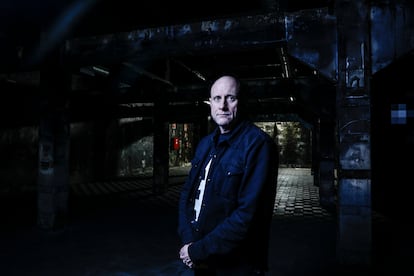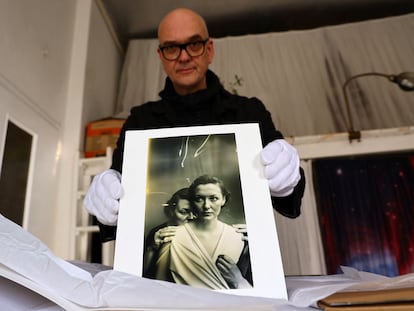From secret CIA prisons to the images that train AI, Trevor Paglen looks where we cannot see
The conceptual artist delves deep into the computer vision systems that teach machines how to perceive images

In the not-too-distant future, an article like the one you are reading right now, an identical text, presenting the same words and images for every reader, no matter if they are in London or in New York, will not be what is displayed on your screen. Soon, artificial intelligence will produce specific content for the specific individual, a person with a first and last name, perhaps a height of 5′9″, an amateur handball player with a marked interest in topics related to science. If a few years ago most uses for computer vision (which teaches machines to understand images just as humans do) and artificial intelligence consisted of “collecting information in order to do something with it, whether that is to understand something about your personality so I can sell you something or to set up a camera system to navigate a drone or a car, the generative turn is about being able to produce images, texts and materials that are intended for somebody to consume.”
The one who warns of this twist in the dizzying evolution of AI is Trevor Paglen, who has been researching for years at the intersection where art and technology meet. “You might like the color blue and I might like the color green more, so you might have an image generated for you attached to an article that is designed to appeal to your preferences,” explains the conceptual artist on the terrace of the Matadero Madrid center, where he recently gave a talk entitled Machine Visions about the origin of AI, and where he has a video installation that can be visited until February 25. “And that’s just the basics,” he adds. “The types of media that tend to get traction on the internet are the ones that are very specifically designed to tug on our emotions and to manipulate us, and I think that generative AI opens up a world of possibility to do that that will make the Facebook and TikTok algorithms look very crude in comparison. I worry a lot about that,” he continues, and reflects: “There is a conspiracy theory that’s been very popular in the last 10 years or so, that we’re all living in a simulation, that nothing is real and everything is being manipulated for us. And I sometimes think, ‘Oh, that’s true.’”
Born and raised in different American bases and trained as a geographer, the beginning of Paglen’s artistic career revolved around images related to the military apparatus: he has photographed secret places and landscapes that supposedly do not exist, underwater cables, surveillance systems, drones and satellites — in other words, he has taken it upon himself to make visible what is usually invisible to our eyes; to look at the systems that look at us. “I started out looking at CIA operations during the war on terror. I was trying to understand the secret prisons that the CIA was running around the world,” he explains. “From there, I worked on drones, and I spent a lot of time working with Laura Poitras [the director of documentaries such as Citizenfour, about whistleblower Edward Snowden], looking at the National Security Agency and how the internet was being turned into a tool of mass surveillance. And you look at that for a while and you realize, ‘Okay, well, there’s a much bigger thing than the NSA, called Google, called Amazon, called Microsoft.’”

Behold These Glorious Times!, Paglen’s installation at the Matadero Madrid center, offers an immersion in the AI systems that use computer vision, trained on tons of images to which humans do not have access, as they are created by computers for the consumption of the computers themselves. Again, the paradox of the visible that cannot be seen. But also images as a language and as a means of mass manipulation, now fragmented into eight billion people.
Created in 2017 (which, in terms of the evolution of AI, makes it a relic by now), this video piece is based on models capable of recognizing different types of flowers. With an endless stream of images, little by little the visual flow turns more and more personal and strange. The system begins to see images of household objects and faces before moving on to private images of people with their children or in their rooms. “It’s telling the story of a kind of creep in the technology, from a moment when it is initially conceived as a way to classify things to something that is designed to extract some kind of value from looking at the most intimate moments of your life.”
Paglen takes his time answering questions. He stops, reflects and shoots. After all, he is talking about extremely complex topics, concepts that slip through the fingers of most of us mortals, living our lives up to our necks in technology, but at the same time deeply ignorant of how it works and what its consequences are. When it comes to the law, they say that ignorance does not exempt from compliance, but in the case of artificial intelligence Paglen believes that, no matter how much each of us incessantly feeds the beast with all kinds of photographs, videos and personal information, we should not bear the responsibility for the (mis)use that large corporations make of it.
“The models are trained with data from the past, but AI didn’t exist back then. Is it fair for those companies to go back in time and tell you that you consented to something that didn’t even exist?” he ponders. “And that’s a question with a lot of cloud-based technologies in general, as you’re often doing something in a context and that context can change in the future.”
It could be said that this same concept, that of context, constitutes one of the master pillars that support the artistic endeavor of Paglen, who divides his work between New York and Berlin. “This is not happening in a vacuum,” he remarks. “In other words, the things that we’re being asked to believe, or to perceive, are coming always from places that have either an economic or a political agenda, and those tend to be quite reactionary.” Although there are humans behind the AI, it is important to know who those humans are and what exactly they are after. Hence the importance of investigating, sharing, raising awareness. In this case, using art as a vehicle. “I find it valuable to try to look at the world from as many different perspectives as possible,” he says. “Because I think that perhaps the closest we can get to the truth is by trying to create as many ways of seeing as we can. For myself, I find art can be enormously helpful in doing that.”
Sign up for our weekly newsletter to get more English-language news coverage from EL PAÍS USA Edition
Tu suscripción se está usando en otro dispositivo
¿Quieres añadir otro usuario a tu suscripción?
Si continúas leyendo en este dispositivo, no se podrá leer en el otro.
FlechaTu suscripción se está usando en otro dispositivo y solo puedes acceder a EL PAÍS desde un dispositivo a la vez.
Si quieres compartir tu cuenta, cambia tu suscripción a la modalidad Premium, así podrás añadir otro usuario. Cada uno accederá con su propia cuenta de email, lo que os permitirá personalizar vuestra experiencia en EL PAÍS.
¿Tienes una suscripción de empresa? Accede aquí para contratar más cuentas.
En el caso de no saber quién está usando tu cuenta, te recomendamos cambiar tu contraseña aquí.
Si decides continuar compartiendo tu cuenta, este mensaje se mostrará en tu dispositivo y en el de la otra persona que está usando tu cuenta de forma indefinida, afectando a tu experiencia de lectura. Puedes consultar aquí los términos y condiciones de la suscripción digital.
More information
Archived In
Últimas noticias
Most viewed
- Sinaloa Cartel war is taking its toll on Los Chapitos
- Oona Chaplin: ‘I told James Cameron that I was living in a treehouse and starting a permaculture project with a friend’
- Reinhard Genzel, Nobel laureate in physics: ‘One-minute videos will never give you the truth’
- Why the price of coffee has skyrocketed: from Brazilian plantations to specialty coffee houses
- Silver prices are going crazy: This is what’s fueling the rally











































